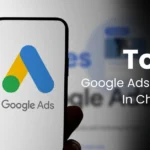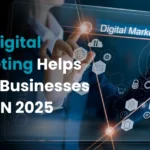Artificial intelligence (AI) has arrived and is revolutionizing the marketing sector; it is no longer simply a futuristic technology concept. You don’t want to get left behind as a marketer. You can enhance results, deliver personalized services at scale, and streamline operations with the right AI tools and strategies. To help marketers stay ahead of the competition, we’re going to look at 9 AI hacks in this article.v
1. Leverage AI for Predictive Analytics

How to implement:
- Analyze customer behavior using technologies like Salesforce Einstein or HubSpot’s Predictive Lead Scoring to rate leads according to their likelihood to convert.
- To help you develop personalized campaigns, integrate AI-powered analytics into your CRM to track consumer interactions and trends.
2. Personalize Content and Messaging at Scale

How to implement:
- Utilize resources – such as Optimizely or Dynamic Yield to personalize recommendations for products and web experiences based on real-time user data.
- Make use of email marketing automation platforms like Klaviyo or Mailchimp, which employ AI to personalize email content, product recommendations, and subject lines for different types of audiences.
3. Automate Social Media Management with AI

How to implement:
- To schedule posts and track engagement, use social media management tools such as Hootsuite or Buffer. These platforms use AI to maximize reach – by optimizing content and posting times.
- Use chatbots powered by AI, such as ManyChat or MobileMonkey, to manage customer interactions on social media sites like Facebook and Instagram.
4. Optimize Advertising Campaigns with AI

AI has the potential to completely revolutionize paid advertising campaign management. Ad design, bidding, – and optimization may all be automated with AI-powered solutions, improving results while needing less work. AI can improve your budget allocation, determine which ads are most likely to perform well, and instantly modify bids to maximize return on investment (ROI).
For instance, machine learning algorithms are used by Google Ads and Facebook Ads to optimize ad placement – and targeting using real-time data. AI is also capable of analyzing the actions of competitors and adjusting your strategy accordingly.
How to implement:
- Make use of Google Ads’ Smart Bidding feature, which adjusts your bids according to the likelihood of a conversion using machine learning.
- Make use of Facebook Ads Manager’s machine learning features to automate creative optimization and ad targeting.
5. AI-Powered SEO and Content Creation

Although it’s constantly evolving, search engine optimization, or SEO , is a crucial part of any digital marketing strategy. By analyzing search engine algorithms , identifying keywords, and refining your content effectively, artificial intelligence (AI) tools can assist you in staying on top of these changes. By generating blog posts, product descriptions, and even social media captions, AI may also expedite the process of creating content.
Your content team can save time and effort by using AI-based writing assistants like Copy.ai or Jasper (formerly known as Jarvis) to help generate excellent, SEO-optimized content.
How to implement:
- To optimize your content for search engines , use Frase or Surfer SEO. These tools analyze top-ranking pages and offer keywords, topics and strategies to boost the relevancy of your content.
- For AI-driven content creation , use Copy.ai or Jasper. Everything from blog entries to email newsletters and social media content can benefit from these tools.
6. Enhance Customer Support with AI Chatbots

Chatbots powered by AI can significantly enhance your customer support experience. They can provide prompt answers to common inquiries , fix issues, and assist customers with the purchasing process. Wait times are reduced and your support team may focus on challenging issues.
Chatbots can help with lead creation in addition to customer service by screening leads and gathering contact information before transferring it to a sales team. You may incorporate chatbots into your email marketing, website, and even social media accounts.
How to implement:
- Integrate AI-powered chatbots on your website and customer support channels , such as Zendesk or Intercom.
- To generate leads, use AI bots such as Drift. Real-time lead generation, question answering, and visitor engagement are all possible with these bots.
7. Improve Customer Segmentation with AI

By analyzing massive amounts of data from multiple sources, artificial intelligence (AI) can assist you in accurately segmenting your audience. It can identify trends in consumer behavior, allowing you the ability to divide your audience into more specific groups according to their demographics, preferences, or actions.
This increases the chances of conversion by enabling you to send more focused communications. AI might, for example, use surfing or past purchases to identify a group of customers who are likely to purchase specific products.
How to implement:
- Utilize technologies such as Segment or Clevertap for gathering customer data and create advanced segments according to interactions, behavior, – and interests.
- Integrate segmentation driven by AI into your CRM platform (such as Salesforce or HubSpot) for creating personalized offers, retargeting ads, and email campaigns.
8. Create Interactive Experiences with AI

Your customers can have highly engaging experiences with AI. You can provide a more engaging and personalized experience with tools like virtual assistants and augmented reality (AR) , which can increase engagement and conversions.
To help customers see how a product would look before making a purchase , IKEA, for instance, uses augmented reality (AR) technology in its app to allow users to visually place furniture in their homes. Likewise, Sephora’s Virtual Artist allows users to use the camera on their phone for trying makeup products.
How to implement:
- To integrate augmented reality features into your app or website, use AR platforms such as Blippar or ZapWorks.
- Use product finders or virtual assistants driven by AI to help customers navigate your offerings and suggest the best products based on their preferences.
9. Track and Analyze Campaign Performance with AI

AI solutions can help you make data-driven decisions by offering comprehensive insights into the performance of your marketing activities. You can monitor everything from customer acquisition costs to customer lifetime value and identify areas for improvement using AI-powered analytics platforms.
Using past data, AI can additionally predict future performance, allowing you to make vital strategy adjustments before it’s too late.
How to implement:
- To track your campaigns and get useful insights, use AI-powered analytics solutions like Adobe Analytics, Tableau, or Google Analytics 4.
- Use AI-driven attribution models to gain a deeper understanding of how each marketing touchpoint impacts the customer journey.
The Final Word
Artificial intelligence is more than a trend; it’s a vital tool that can enhance marketing strategies, save time, and deliver better results. AI offers countless opportunities to develop your marketing initiatives, from AI-driven SEO and customer support to predictive analytics and personalized content.
You may increase your ROI, improve customer experiences, and streamline your process by implementing these 9 AI hacks. The key is to accept AI as a valuable partner in your marketing strategy, which will allow you to work more effectively and smartly. AI is a tool that can help you to stay ahead of the curve in the fast-paced marketing world of today.








